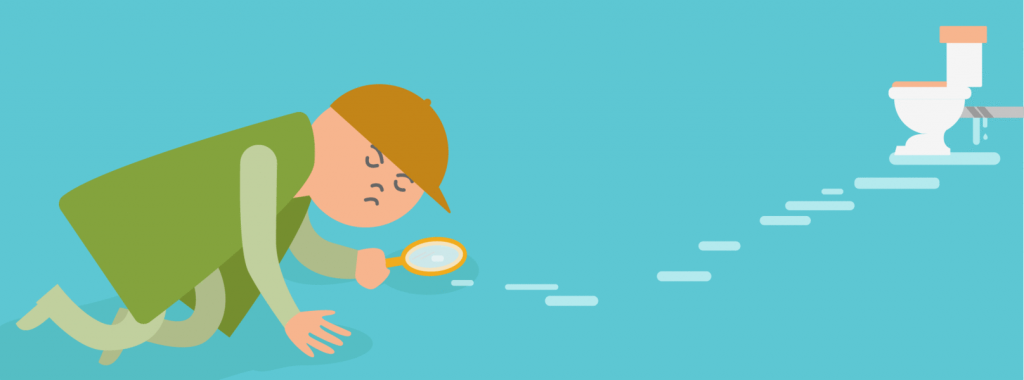
Water leaks happen. In fact, they happen a lot. Data that WaterSmart has collected from over 4 million households indicates that as many as 50% of households will experience some type of water leak within a given year. And more than 10% of households have leaks that waste at least 90 gallons per day. In addition to the frequency that leaks occur, they can be quite expensive. The U.S. insurance industry pays out about $2.5 billion each year in homeowner insurance claims due to water damage from leaks. That’s nearly $7,000 per household which is the number two home insurance claim annually.
More than 10% of households have leaks that waste at least 90 gallons per day!
Water damage happens for a variety of reasons and some of these causes are unavoidable. Catastrophic weather events that lead to floods or broken pipes and leaky roofs can result in damage that is often expensive to repair. However, most leaks are more mundane and, if not entirely avoidable, easily addressed if caught quickly before extensive damage occurs. Common issues such as leaky toilets, worn faucet gaskets, frayed connection tubes, and irrigation system ruptures can be addressed by nearly any homeowner without the need for a plumber and at very low cost.
The trick is to catch the issue early and have a process by which to identify the likely source of the irregular water use. This is where data and technology come in to play. By actively monitoring water consumption through modern data analytics platforms, water customers can be automatically notified when changes in water use indicate a leak. This gives the end-user the opportunity to address the underlying problem before it has the opportunity to develop into a messy and costly hassle.
Yet the question naturally arises: Why would water utilities want to invest in helping their customers quickly identify leaks? Since household leaks are metered and charged for, wouldn’t notifying customers of leaks result in lower water revenues? Also, when customers are notified of possible irregular usage patterns, it’s not uncommon for them to contact their water utility demanding the utility send a field staff member to come fix the problem or call a plumber.
Given these considerations, it seems it would be advantageous for utilities to allow leaks to persist, bill for the additional consumption, and avoid the hassle of customer complaints. Cynical? Perhaps. Fortunately there are several very sound reasons why utilities do not (and should not) behave this way:
- Supporting customers costs water utilities a lot of money every year. Every call to customer support costs between $3-7 (roughly $1 / minute), and unresolved calls, call escalations, and truck rolls for onsite service requests can drive these costs much, much higher. Therefore, it behooves every utility to find ways to avoid customer calls by offering self-service technologies, or at least provide customer service representatives with easy-to-use tools to help to quickly, and permanently, resolve caller concerns.
- A corollary of water leaks are the resulting high bills that come with increased usage. In fact, bill related issues are shown to account for up to 70% of all customer support calls. Consequently, it is beneficial for water utilities to do whatever they can to avoid surprising their customers with unusually high bills.
- Many customers don’t understand that leaks that occur ‘behind’ the meter (on the household side as opposed to on the utility distribution line side of the meter) are generally the responsibility of the home owner, not the utility. As a result, many users will call their utility to repair household leaks, lateral line damage, or other water related issue that is actually not the responsibility of the utility.
The emerging use of smart meter technology is leading to a sea change in the way that water utilities manage customer-side leaks, and communicate with end-users about those issues. By looking at regular interval of water consumption that is automatically streamed from the customer water meter, modern data analytics platforms can identify irregular usage patterns that could indicate a possible leak. These systems can then send automated messages to utility staff and customers that notify them of the change in water use. The most advanced of these leak notification systems also offer leak resolution wizards that walk customer through a step-by-step process to self-resolve issues, thus reducing calls to customer support services, and avoiding high bill surprises.
Advanced systems offer leak resolution wizards that allow customers to self-resolve issues
Even when utilities do not have the ability to digitally communicate with customers about leaks due to a lack of an email address or mobile phone number, automated print leak alerts can not only accomplish this job, but also serve to drive more users to register for future email communications, thus digitizing the customer and generating opportunities to reduce future communication costs.
Leak detection has emerged as the killer application for smart water networks. While smart meters benefit utilities by reducing the costs of reading meters, they also provide end-use customers with detailed information on their water use (including leaks) that can help them better manage their spend and protect their property from costly water damage.
It should, however, also be noted that leak detection is not limited to the availability of smart meters. While discrete interval data on water consumption can be valuable in identifying low-volume leaks, daily and monthly data from automated meter reading systems can also yield insightful information on possible leaks. In any case, the ability to proactively communicate with customers about water use is the first step to educating users on the value of water services, and gaining support for ongoing investments in our water systems to ensure reliability and public health for the foreseeable future.


